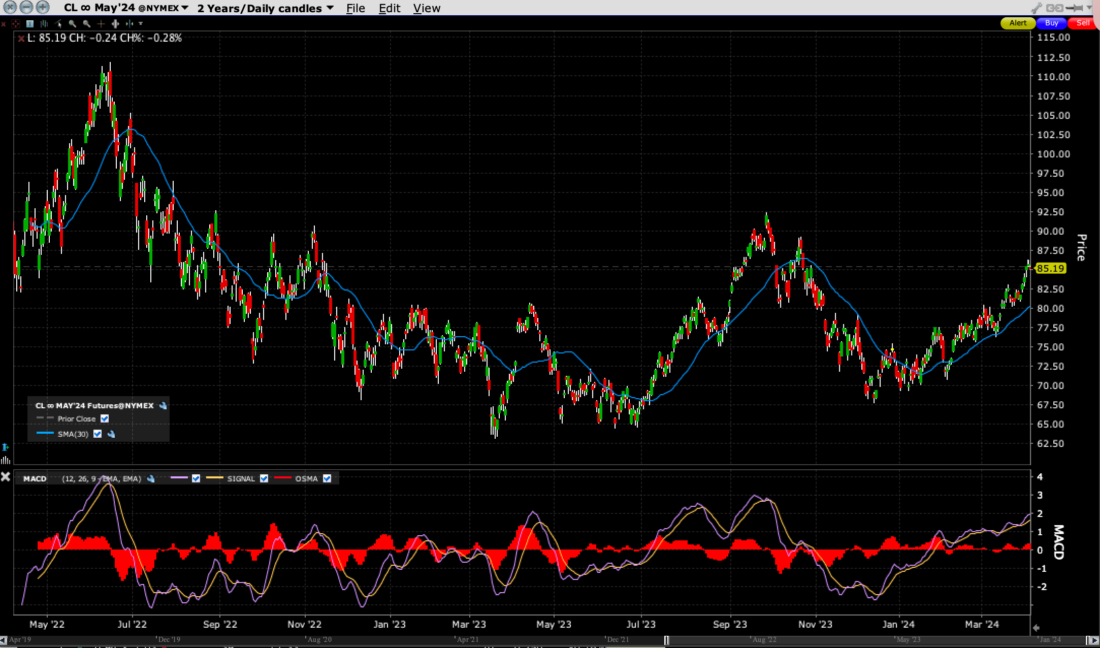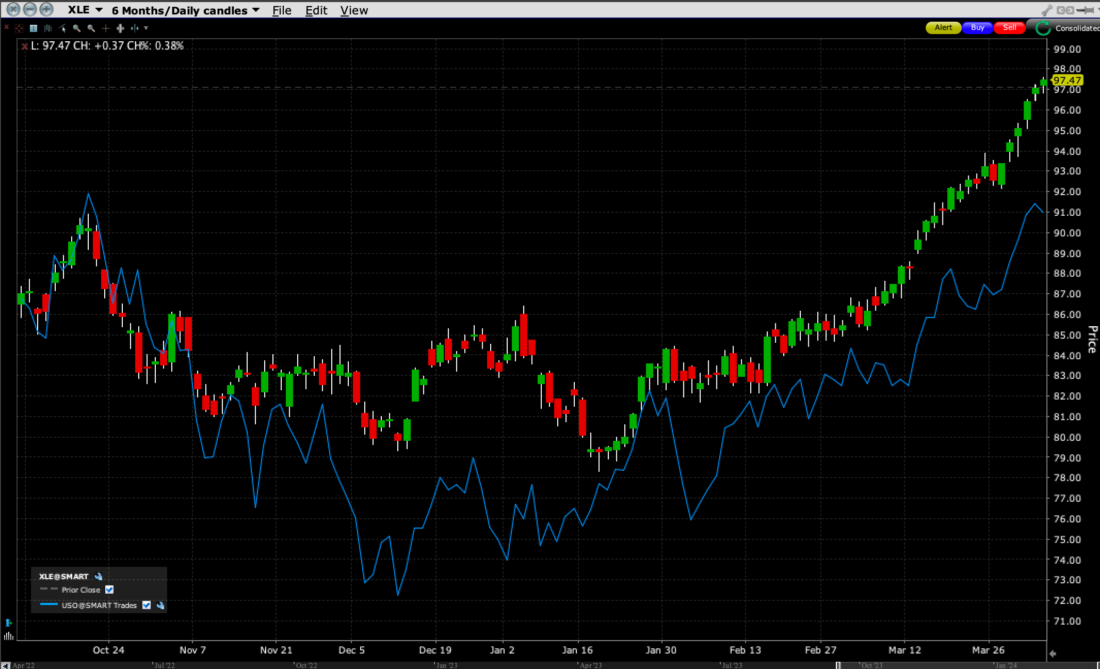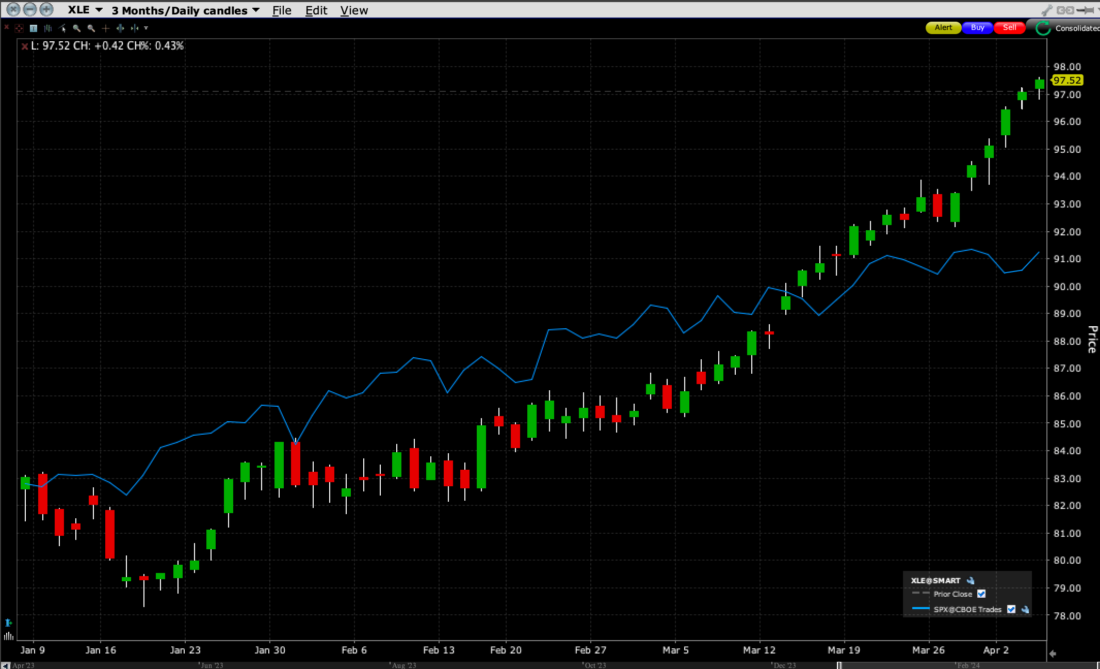One of my first jobs was a summer internship with a technical analyst. In those days, charting was considered by many to be akin to voodoo. The practitioners pored over their graphs, many of which were hand-drawn, trying to discern patterns that could guide one’s trading and/or investing behavior. We can engage in a long debate about the pros and cons of charting and technical analysis, but my experience as an intern helped shape the views that I honed as a long-time trader: technical analysis is hardly a panacea, but investors who ignore basic lessons about trends, momentum, support, and resistance are missing important long and short-term timing tools.
While doing my usual rounds of key charts, I noticed that arguably the most important commodity seems to be forming an important technical pattern – a double bottom. Below is a two-year chart of rolling front month crude oil futures (CL):
CL Futures, 2-year Daily Candles (red/green, top), 30-day Moving Average (blue, top), MACD (12,26,9, bottom)

Source: Interactive Brokers
To my eye, the recent bounce in crude oil prices appears to be a potential double bottom. As with so many financial products, prices have recently been rising in a well-defined trend, but the longer-term view shows that oil found support around the $70 level and has since turned higher. The short-term target appears to be the $90 resistance area, but the longer-term pattern suggests that a break above that level is possible. And while that would be good for those who hold energy stocks, it would be bad for most everyone else.
We’ve all had it drummed into our minds that the Federal Reserve’s preferred measure of inflation is the PCE Core Deflator. Core inflation measures exclude volatile food and energy components, which by definition mean that oil’s rise should have little to no impact. But here’s the problem: the Fed is also concerned about managing inflationary expectations, and energy prices are a key determinant. The following chart shows the relationship between University of Michigan 1-Year Inflation Expectations and AAA National Unleaded Gasoline Prices:
University of Michigan 1-Year Inflation Expectations (yellow) vs. AAA National Unleaded Gasoline Prices (green) Since December 2016

Source: Bloomberg
There is clearly not a perfect relationship between pump prices and inflationary expectations, but they certainly move in the same general direction. Lately it appears that inflationary expectations lag gasoline prices by about one- to two-months. If we are indeed seeing sustainably higher energy prices, then inflationary expectations are likely to follow. And that would complicate the Fed’s fight against inflation.
In the short term, if the chart pattern is to be believed – and if you believe that we are more likely to see a sustained advance in oil prices rather than a short-term trend that is closer to its natural end – then gaining exposure to the sector would make sense. Those with a high risk tolerance can trade energy futures and options directly, while many investor might favor equity-related methods, such as energy stocks and/or ETFs. The following graph shows the recent relationship between XLE, a popular energy sector ETF, and USO, a publicly traded limited partnership that holds oil futures:
6-Month Chart, XLE (red/green candles) vs. USO (blue line)

Source: Interactive Brokers
Thanks to the ebullient stock market, we see that energy stocks have generally outperformed the underlying commodity recently. That is a standard feature of any sector that is closely linked to a commodity. The commodity strongly influences the stocks, but the tone of the equity market influences whether the stocks outperform or underperform.
Besides my early lessons about how price charts reflect supply and demand for the stock or commodity in question, another early lesson comes to mind: become concerned if oil stocks lead the market because it indicates that inflationary pressures are taking root. Considering how we’re all so focused on technology stocks (guilty), it was easy to overlook that energy stocks have indeed begun to outpace the broad market as a whole. Pay close attention to how the S&P 500 (SPX) has moved up at a much slower pace than XLE:
3-Months XLE (red/green candles) vs. SPX (blue line)

Source: Interactive Brokers
Does this one chart mean that investors should start heading for the exits? No. A key tenet of technical analysis is not to put too much faith in one single chart or indicator. But it is one more data point that could spur investors to consider more defensive strategies. We outlined several of them earlier this week.
One should always respect the messages that the market is sending, and technical analysis offers one way to do that.
Join The Conversation
For specific platform feedback and suggestions, please submit it directly to our team using these instructions.
If you have an account-specific question or concern, please reach out to Client Services.
We encourage you to look through our FAQs before posting. Your question may already be covered!
Leave a Reply
Disclosure: Interactive Brokers
The analysis in this material is provided for information only and is not and should not be construed as an offer to sell or the solicitation of an offer to buy any security. To the extent that this material discusses general market activity, industry or sector trends or other broad-based economic or political conditions, it should not be construed as research or investment advice. To the extent that it includes references to specific securities, commodities, currencies, or other instruments, those references do not constitute a recommendation by IBKR to buy, sell or hold such investments. This material does not and is not intended to take into account the particular financial conditions, investment objectives or requirements of individual customers. Before acting on this material, you should consider whether it is suitable for your particular circumstances and, as necessary, seek professional advice.
The views and opinions expressed herein are those of the author and do not necessarily reflect the views of Interactive Brokers, its affiliates, or its employees.
Disclosure: Futures Trading
Futures are not suitable for all investors. The amount you may lose may be greater than your initial investment. Before trading futures, please read the CFTC Risk Disclosure. A copy and additional information are available at ibkr.com.
Disclosure: ETFs
Any discussion or mention of an ETF is not to be construed as recommendation, promotion or solicitation. All investors should review and consider associated investment risks, charges and expenses of the investment company or fund prior to investing. Before acting on this material, you should consider whether it is suitable for your particular circumstances and, as necessary, seek professional advice.



















Hi Steve,
Excellent article and shared information. It would be nice, as a constructive feedback, if your awesome articles could incorporate a top summary of your discussion with focus on main points. This way, many investors, like me, won’t have to spend too much time reading through the whole story (not that is not important, which I know it is). However, with this rapid moving world, we just need to become smarter when sharing data. 🙂
Cheers and appreciate all your work.
Hello, we appreciate your kind words and have passed along your feedback to the appropriate team.
Hmm – FWIW, none of the candle charts are displayed in FireFox browser, but are shown in Edge.
I don’t see a sustained advance in oil prices, certainly not in an election year.
The XLE has had a hekuva run, might be a good short here.
Today’s selloff on Fedspeak may be totally forgotten by next week.
I think this scenario is very plausible, considering seasonality and global activities, shorting crude wouldn’t be on my list of strategies.
If world wide political tensions continue and or increase Biden may have no choice other than to start filling the Strategic Petroleum Reserves. This will cause upward price pressure for oil.
I am using Firefox and have no trouble with the charts not displaying
Election year, indeed.
A double bottom? I do not see any bottoms and much less a double bottom.
If you stretch the concept (and ignore the top at ~$92.50), there are 3 tops ~$90; 2 tops ~October /22 and 1 top ~October /23.
If anything a triple top is a formidable resistance level that is not easy to break through. If the price cannot break the triple top, then watch out below. If the price does break above the triple top, then the sky is the limit, a figure of speech.
Great article Steve! The advance in oil and commodity prices reflect USD debasement in my humble opinion.
We hope you continue to enjoy Traders’ Insight!
Charts are not working in Safari and Orion.
Please create a web ticket and include the screenshot, so our technical support team can provide further assistance: https://spr.ly/IBKR_TicketCampus
I hold both NG and oil stocks and mineral rights, and have been involved in the industry since I began to understand discussions at the dinner table in the 50’s. My Dad was an oil and gas accountant and lobbied Teddy Kennedy and Scoop Jackson to reinstate the oil and gas depletion allowance in ’72, when oil was $22/bbl, to avoid becoming dependant on foreign. Of course his facts and figures were ignored because they didn’t fit their ideology, so 2 years lat and it was at $70/bbl (and we have been dependant on foreign oil ever since), which they blamed on greed from big oil. I also hold some tanker assets, particularly oil and LNG, and keep my ear close to this as well,so I am encouraged by the thought of higher prices for energy. EV falling out of favor due to inadequate infrastructure issues has also had an impact, as well at the war in the middle east, which is the issue with the most immediate impact. However, most of these are short term issues, either for the next few months or the next few years, so I think any spike will only run for that perioed, this time, until the next unexpected development. Coal is in rising demand, especially as oil and NG prices go up, but I divested myself of coal interests some time ago for personal reasons. NG has always been the ‘bridge’ energy for the next 100 years, but Pickens, et al need to become more effective at getting past the zero C crown, as it is impossible for the next several years. It’s the best way to make the electricity now, and Li mining/conversion is horrendously pollutting and leads to massive strip mining, so once they figure that out they will have something else to OMG about. There is a fairly new process for developing Li that was developed by an independat chemist, that uses Li ‘metal’ and is able to avoid the mining and conversion problems with the ore. Interestingly enough, one of the most prolific sources for the Li metal is waste water from fracking wells. EXN has been buying up a lot of this old prjects recently in the Permian, so something will probably happen there in the next few years that will have an impact on what the world uses for energy. I suspect that China will become the EV capitol of the world before too long, for various reasons.